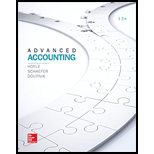
a.
Prepare Company P’s entries to account for the consideration transferred to the former owners of Company S, the direct combination costs, and the stock issue and registration costs.
a.
Explanation of Solution
| General Journal | ||||
| Date | Account Title and Explanation | Post Ref. | Debit ($) | Credit ($) |
| i) | Receivables and inventory | $ 180,000 | ||
| Cash | $ 85,000 | |||
| Property, plant and equipment | $ 600,000 | |||
| Research and development asset | $ 100,000 | |||
| Trademarks | $ 200,000 | |||
| $ 77,500 | ||||
| Liabilities | $ 180,000 | |||
| Common stock | $ 250,000 | |||
| Additional paid-in capital | $ 750,0000 | |||
| $ 62,500 | ||||
| (to record the assets and liabilities acquired) | ||||
| ii) | Professional service | $ 15,000 | ||
| Cash | $ 15,000 | |||
| (being Stock issuance cost paid) | ||||
| iii) | Additional paid-in capital | $ 9,000 | ||
| Cash | $ 9,000 | |||
| (being Stock issuance cost paid) | ||||
Table: (1)
Computation of the fair value of the consideration transferred:
Thus, the fair value of the consideration transferred in this combination is $1,000,000.
b.
Prepare a post-acquisition column of accounts for company P.
b.
Explanation of Solution
The post-combination balance sheet for Company P as of the acquisition date is as follows:
| Particulars | Company P | Company S | Consolidated Entries | Consolidated Balances | ||
| Revenues | $ (1,200,000) | $ (1,200,000) | ||||
| Expenses | $ 890,000 | $ 890,000 | ||||
| Net income | $ (310,000) | $ (310,000) | ||||
| $ (950,000) | $ (950,000) | |||||
| Net income | $ (310,000) | $ (310,000) | ||||
| Dividends declared | $ 90,000 | $ 90,000 | ||||
| Retained earnings,12/31 | $ (1,170,000) | $ (1,170,000) | ||||
| Cash | $ 86,000 | $ 85,000 | $ - | $ 171,000 | ||
| Receivables and inventory | $ 750,000 | $ 190,000 | $ 10,000 | $ 930,000 | ||
| Property, plant, and equipment | $ 1,400,000 | $ 450,000 | $ 150,000 | $ 2,000,000 | ||
| Investment in Company S | $ 1,062,500 | $ 705,000 | ||||
| $ 357,500 | ||||||
| Research and development asset | $ 100,000 | $ 100,000 | ||||
| Goodwill | $ 77,500 | $ 77,500 | ||||
| Trademarks | $ 300,000 | $ 160,000 | $ 40,000 | $ 500,000 | ||
| Total assets | $ 3,598,500 | $ 885,000 | $ 3,778,500 | |||
| Liabilities | $ (500,000) | $ (180,000) | $ (680,000) | |||
| Contingent liability | $ (62,500) | $ (62,500) | ||||
| Common stock | $ (650,000) | $ (200,000) | $ 200,000 | $ (650,000) | ||
| Additional paid-in capital | $ (1,216,000) | $ (70,000) | $ 70,000 | $ (1,216,000) | ||
| Retained earnings | $ (1,170,000) | $ (435,000) | $ 435,000 | $ (1,170,000) | ||
| Total liabilities and equities | $ (3,598,500) | $ (885,000) | $ 1,072,500 | $ 1,072,500 | $ 3,778,500 | |
Table: (2)
c.
Prepare a worksheet to produce a consolidated balance sheet as of the acquisition date.
c.
Explanation of Solution
The worksheet to consolidate the two companies as of the combination date is as follows:
| Particulars | Company P | Company S | Consolidated Entries | Consolidated Balances | ||
| Revenues | $ (1,200,000) | $ (1,200,000) | ||||
| Expenses | $ 890,000 | $ 890,000 | ||||
| Net income | $ (310,000) | $ (310,000) | ||||
| Retained earnings, 1/1 | $ (950,000) | $ (950,000) | ||||
| Net income | $ (310,000) | $ (310,000) | ||||
| Dividends declared | $ 90,000 | $ 90,000 | ||||
| Retained earnings,12/31 | $ (1,170,000) | $ (1,170,000) | ||||
| Cash | $ 86,000 | $ 85,000 | $ - | $ 171,000 | ||
| Receivables and inventory | $ 750,000 | $ 190,000 | $ 10,000 | $ 930,000 | ||
| Property, plant, and equipment | $ 1,400,000 | $ 450,000 | $ 150,000 | $ 2,000,000 | ||
| Investment in Company S | $ 1,062,500 | $ 705,000 | ||||
| $ 357,500 | ||||||
| Research and development asset | $ 100,000 | $ 100,000 | ||||
| Goodwill | $ 77,500 | $ 77,500 | ||||
| Trademarks | $ 300,000 | $ 160,000 | $ 40,000 | $ 500,000 | ||
| Total assets | $ 3,598,500 | $ 885,000 | $ 3,778,500 | |||
| Liabilities | $ (500,000) | $ (180,000) | $ (680,000) | |||
| Contingent liability | $ (62,500) | $ (62,500) | ||||
| Common stock | $ (650,000) | $ (200,000) | $ 200,000 | $ (650,000) | ||
| Additional paid-in capital | $ (1,216,000) | $ (70,000) | $ 70,000 | $ (1,216,000) | ||
| Retained earnings | $ (1,170,000) | $ (435,000) | $ 435,000 | $ (1,170,000) | ||
| Total liabilities and equities | $ (3,598,500) | $ (885,000) | $ 1,072,500 | $ 1,072,500 | $ 3,778,500 | |
Table: (3)
Want to see more full solutions like this?
Chapter 2 Solutions
Soft Bound Version for Advanced Accounting 13th Edition
 Intermediate Accounting: Reporting And AnalysisAccountingISBN:9781337788281Author:James M. Wahlen, Jefferson P. Jones, Donald PagachPublisher:Cengage Learning
Intermediate Accounting: Reporting And AnalysisAccountingISBN:9781337788281Author:James M. Wahlen, Jefferson P. Jones, Donald PagachPublisher:Cengage Learning


